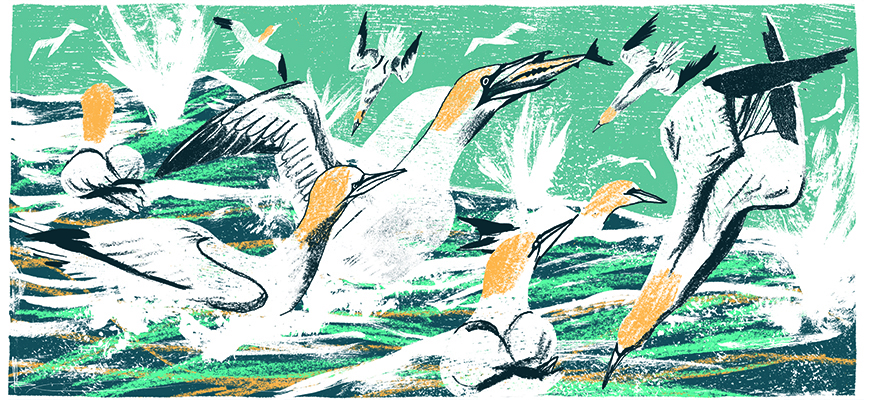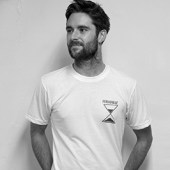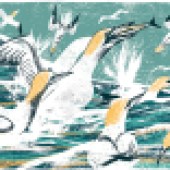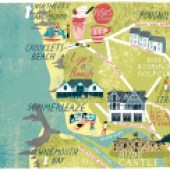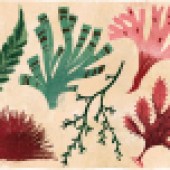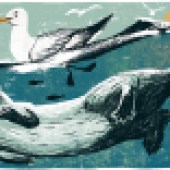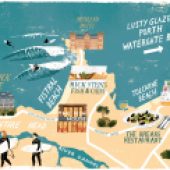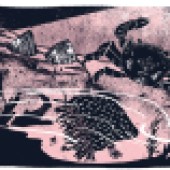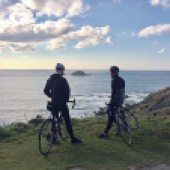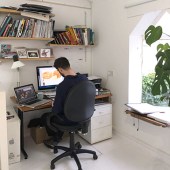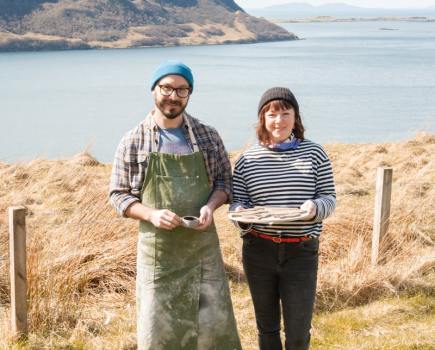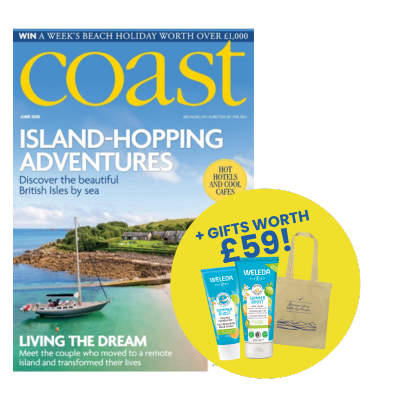Exchanging city living for being by the coast has brought rich rewards for illustrator Tom Jay, who moved from London’s Hackney to a home – and studio – in Cornwall. Words: Sue Herdman
When illustrator Tom Jay downs tools at the close of a working day, he’s spoilt for choice for what to do next. From his airy studio in Penryn, on a promontory between two creeks near Falmouth, he can join the coastal path from near the quay and take a run to the waterside village of Flushing. From there he’ll navigate Trefusis Head, with its cave and steps cut into the foreshore, before swinging back to Penryn. Alternatively, he might cycle the north coast to the beach at Porthtowan; or he’ll head south to Porthleven with its bay and harbour, where small fishing boats land the daily catch. Whichever route he chooses, Tom can soak up spectacular views, some of which work their way into his illustrations, if a sense of landscape is called for. That access to the outdoor life is a boon for Tom, who loves nature, surfing and kayaking. And it’s a long way from the urban environment he had before, in London. ‘I loved living in the capital,’ he says, ‘but I found myself heading for the sea whenever there was any free time. I got into cycling, so I’d go down to Brighton, or to sites in Kent or Suffolk, and often end the day on the beach with some fish and chips.’
THE PULL OF THE SEA
It’s no surprise that the lure of the west was to win through for Tom. He grew up in Devon. His childhood memories are filled with recollections of days swimming at Budleigh Salterton, messing about in boats on the Exe and, from the age of 11, catching the surf. His mother was an illustrator, who worked particularly on books for children; she is now a painter. ‘Art, as a result, was really encouraged at home,’ Tom says, ‘but not pushed. Mum’s career did show me, though, that being an illustrator could be an actual job, not just a hobby.’ Having shown real promise in art at school, he went on to take an Art Foundation course and, following that, specialised in illustration at Falmouth University, which at the time ‘was the best course in the subject in the country’. It had an added bonus ‘of being next to the waves.’ The university is also based in Penryn, so in many ways, life has come full circle.
On graduating in 2010 the hard graft of getting established as an illustrator began. Tom describes his style as ‘a combination of bold textures, playful imagery and conceptual ideas.’ One of his chief influences has been the work of the Cincinnati-based American Modernist artist Charley Harper, who died in 2007. Harper had what has been described as ‘an alternative way of looking at nature,’ creating bold, beautiful, stylised works, often with a touch of humour. Such elements feature in Tom’s approach to his illustration. Coast readers will recognise his work from past issues, with its joyful, graphic take on scenes from our shores, from seaside towns to coastal nature. ‘I have a strong interest in wildlife,’ he says, ‘so being asked to illustrate, say, gannets gliding low over the waves for one of coast’s wildlife columns, is my idea of a great commission.’ He is also drawn to the contrasts of the Cornish landscape, ‘especially the different textures it holds: the fields, trees and rocks.’
Although he works digitally, he draws all the elements of each image by hand, employing techniques that range from paint to ink, pencil or stencil; he then collates the work digitally, changing colours or making any necessary edits. His illustrations can be seen globally, in newspapers and major magazines, with subjects ranging from travel to food and drink and political vignettes.
CLOSE TO THE QUAY
Tom’s career as an illustrator enables him to work remotely, which made his decision to move to Cornwall a smooth one. After searching the market, he found his new home on one of the oldest streets in Penryn, which itself was one of the earliest market towns in Cornwall. Once the main port on the river, trading in fish, tin, granite and copper, it has winding streets and architecture from the Tudor, Jacobean, Georgian and Victorian eras. The quay lies at the end of his road and, close by, is the town’s museum. It was there that he discovered a little more about his new home and its situation. It was built in the 18th-century, with thick granite walls and sash windows, and is one-third of a building, which he now believes to have been one of Penryn’s past coaching houses. The town, which is largely overlooked by tourists, is a conservation area and, where once there were merchant warehouses and chandlers, there are now galleries, shops and places to eat and drink.
As for a working space, when Tom was in Hackney he shared studios with other creatives. This, happily, is an arrangement that he has been able to continue. ‘I was looking for the same set-up,’ he says, ‘and when I couldn’t find the right thing, I started one.’ The space is now shared with six people, a few illustrators, a graphic designer and an editor. ‘As Penryn is home, in part, to the university, it’s lively, with a thriving art scene,’ Tom says. ‘Getting the studio established has been a great way to meet people who work in the same world that I do.’ The bright, open working area, with a big central table, looks out on one side to the fields and trees by the Penryn river and, best of all, the commute to and from it is just a gentle stroll.
COASTAL CALM
‘This move has been about getting a balance between my working life and my free time,’ Tom says. ‘Now, I’m truly enjoying the lifestyle that I came here for. Creating illustration work is quite sedentary, so I look forward to the activities I can now fit in before and after work. Having the sea and outdoor space on the doorstep has become a great part of my everyday; being able to go for a swim in the sea in summer after work takes some beating. I’ll take a kayak out from Swanpool, the closest beach, paddle out to sea and do a bit of mackerel fishing. When the sun is out and the fish are in, its glorious. Or I might go fishing off the end of a pier in Falmouth. Then, if I’m seeking good evening sun in the late spring and summer months, I’ll head to the Helford beaches. The colours are so rich. Now I have easier access to nature, I can watch how the weather and seasons change the coastal landscape; it’s an inspiration for someone like me, for whom observation is such an important part of my work.’
Find out more about Tom’s illustrations at tomjay.com
TOM’S FAVOURITE THINGS TO DO
1. VISITING ART VENUES
‘The Poly in Falmouth is a theatre, independent cinema and a gallery that provides wonderful cultural activities. There’s always something good on at Tate St Ives too; I like the newly opened gallery space.’
2. EATING OUT
‘I’m a bit of a foodie, and the menu at the Stargazy Café on Penryn’s Lower Market Street is one of the best; another favourite is the Potager Café at Constantine in Falmouth. It’s an organic gardening collective and the café serves delicious food made from the produce. For really good seafood, I head to The Wheelhouse in Falmouth.’
3. HEADING TO THE BEACHES
‘I love Rinsey Cove near Helston, with its ruin of an engine house at the top of the cliffs above the cove. It’s a favoured spot for coasteering, because of its amazing granite formations, but it’s almost always beautifully quiet.’
4. WATCHING WILDLIFE
‘I’m always on the lookout for choughs; they’re a symbolic bird in Cornwall (featuring on the county’s coat off arms). They almost died out in Cornwall, but returned in 2001 and I’ve seen a few on the more western coastal stretches.’
5. STRIDING OUT
‘Cornwall offers such contrasts. If I want a walk that’s tranquil and protected I’ll head for the Helford Estuary. But if I’m after something wilder, I’ll go to The Lizard, to that exposed, windy, weird landscape right at the bottom of Cornwall.’
Exchanging city living for being by the coast has brought rich rewards for illustrator Tom Jay, who moved from London’s Hackney to a home – and studio – in Cornwall. Words: Sue Herdman
When illustrator Tom Jay downs tools at the close of a working day, he’s spoilt for choice for what to do next. From his airy studio in Penryn, on a promontory between two creeks near Falmouth, he can join the coastal path from near the quay and take a run to the waterside village of Flushing. From there he’ll navigate Trefusis Head, with its cave and steps cut into the foreshore, before swinging back to Penryn. Alternatively, he might cycle the north coast to the beach at Porthtowan; or he’ll head south to Porthleven with its bay and harbour, where small fishing boats land the daily catch. Whichever route he chooses, Tom can soak up spectacular views, some of which work their way into his illustrations, if a sense of landscape is called for. That access to the outdoor life is a boon for Tom, who loves nature, surfing and kayaking. And it’s a long way from the urban environment he had before, in London. ‘I loved living in the capital,’ he says, ‘but I found myself heading for the sea whenever there was any free time. I got into cycling, so I’d go down to Brighton, or to sites in Kent or Suffolk, and often end the day on the beach with some fish and chips.’
THE PULL OF THE SEA
It’s no surprise that the lure of the west was to win through for Tom. He grew up in Devon. His childhood memories are filled with recollections of days swimming at Budleigh Salterton, messing about in boats on the Exe and, from the age of 11, catching the surf. His mother was an illustrator, who worked particularly on books for children; she is now a painter. ‘Art, as a result, was really encouraged at home,’ Tom says, ‘but not pushed. Mum’s career did show me, though, that being an illustrator could be an actual job, not just a hobby.’ Having shown real promise in art at school, he went on to take an Art Foundation course and, following that, specialised in illustration at Falmouth University, which at the time ‘was the best course in the subject in the country’. It had an added bonus ‘of being next to the waves.’ The university is also based in Penryn, so in many ways, life has come full circle.
On graduating in 2010 the hard graft of getting established as an illustrator began. Tom describes his style as ‘a combination of bold textures, playful imagery and conceptual ideas.’ One of his chief influences has been the work of the Cincinnati-based American Modernist artist Charley Harper, who died in 2007. Harper had what has been described as ‘an alternative way of looking at nature,’ creating bold, beautiful, stylised works, often with a touch of humour. Such elements feature in Tom’s approach to his illustration. Coast readers will recognise his work from past issues, with its joyful, graphic take on scenes from our shores, from seaside towns to coastal nature. ‘I have a strong interest in wildlife,’ he says, ‘so being asked to illustrate, say, gannets gliding low over the waves for one of coast’s wildlife columns, is my idea of a great commission.’ He is also drawn to the contrasts of the Cornish landscape, ‘especially the different textures it holds: the fields, trees and rocks.’
Although he works digitally, he draws all the elements of each image by hand, employing techniques that range from paint to ink, pencil or stencil; he then collates the work digitally, changing colours or making any necessary edits. His illustrations can be seen globally, in newspapers and major magazines, with subjects ranging from travel to food and drink and political vignettes.
CLOSE TO THE QUAY
Tom’s career as an illustrator enables him to work remotely, which made his decision to move to Cornwall a smooth one. After searching the market, he found his new home on one of the oldest streets in Penryn, which itself was one of the earliest market towns in Cornwall. Once the main port on the river, trading in fish, tin, granite and copper, it has winding streets and architecture from the Tudor, Jacobean, Georgian and Victorian eras. The quay lies at the end of his road and, close by, is the town’s museum. It was there that he discovered a little more about his new home and its situation. It was built in the 18th-century, with thick granite walls and sash windows, and is one-third of a building, which he now believes to have been one of Penryn’s past coaching houses. The town, which is largely overlooked by tourists, is a conservation area and, where once there were merchant warehouses and chandlers, there are now galleries, shops and places to eat and drink.
As for a working space, when Tom was in Hackney he shared studios with other creatives. This, happily, is an arrangement that he has been able to continue. ‘I was looking for the same set-up,’ he says, ‘and when I couldn’t find the right thing, I started one.’ The space is now shared with six people, a few illustrators, a graphic designer and an editor. ‘As Penryn is home, in part, to the university, it’s lively, with a thriving art scene,’ Tom says. ‘Getting the studio established has been a great way to meet people who work in the same world that I do.’ The bright, open working area, with a big central table, looks out on one side to the fields and trees by the Penryn river and, best of all, the commute to and from it is just a gentle stroll.
COASTAL CALM
‘This move has been about getting a balance between my working life and my free time,’ Tom says. ‘Now, I’m truly enjoying the lifestyle that I came here for. Creating illustration work is quite sedentary, so I look forward to the activities I can now fit in before and after work. Having the sea and outdoor space on the doorstep has become a great part of my everyday; being able to go for a swim in the sea in summer after work takes some beating. I’ll take a kayak out from Swanpool, the closest beach, paddle out to sea and do a bit of mackerel fishing. When the sun is out and the fish are in, its glorious. Or I might go fishing off the end of a pier in Falmouth. Then, if I’m seeking good evening sun in the late spring and summer months, I’ll head to the Helford beaches. The colours are so rich. Now I have easier access to nature, I can watch how the weather and seasons change the coastal landscape; it’s an inspiration for someone like me, for whom observation is such an important part of my work.’
Find out more about Tom’s illustrations at tomjay.com
TOM’S FAVOURITE THINGS TO DO
1. VISITING ART VENUES
‘The Poly in Falmouth is a theatre, independent cinema and a gallery that provides wonderful cultural activities. There’s always something good on at Tate St Ives too; I like the newly opened gallery space.’
2. EATING OUT
‘I’m a bit of a foodie, and the menu at the Stargazy Café on Penryn’s Lower Market Street is one of the best; another favourite is the Potager Café at Constantine in Falmouth. It’s an organic gardening collective and the café serves delicious food made from the produce. For really good seafood, I head to The Wheelhouse in Falmouth.’
3. HEADING TO THE BEACHES
‘I love Rinsey Cove near Helston, with its ruin of an engine house at the top of the cliffs above the cove. It’s a favoured spot for coasteering, because of its amazing granite formations, but it’s almost always beautifully quiet.’
4. WATCHING WILDLIFE
‘I’m always on the lookout for choughs; they’re a symbolic bird in Cornwall (featuring on the county’s coat off arms). They almost died out in Cornwall, but returned in 2001 and I’ve seen a few on the more western coastal stretches.’
5. STRIDING OUT
‘Cornwall offers such contrasts. If I want a walk that’s tranquil and protected I’ll head for the Helford Estuary. But if I’m after something wilder, I’ll go to The Lizard, to that exposed, windy, weird landscape right at the bottom of Cornwall.’

